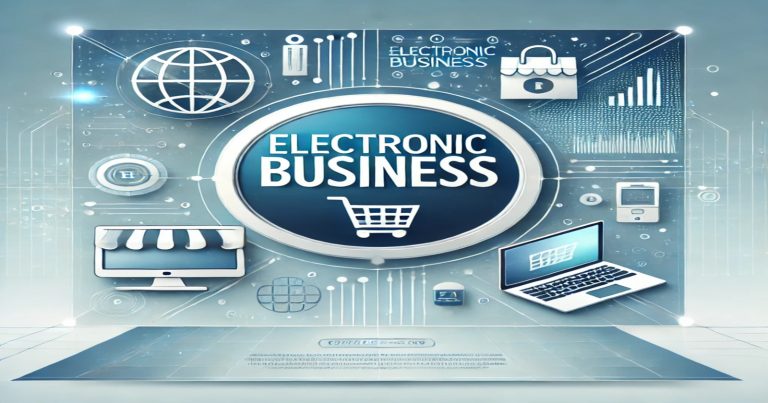E-business is known as conducting business operations through digital platforms and the Internet. This process involves buying and selling, marketing, and managing customer relationships through electronic tools. It basically provides more operational aspects of online business in e-commerce beyond selling products, which considers supply chain management and customer service. In this article, we will look at what electronic business is, types, advantages, disadvantages, and how it is different from e-commerce.
What is Electronic Business?
Electronic business refers to an activity conducted by using internet-based technologies. Nowadays, e-business encompasses nearly all the aspects of a business, such as retails, digital marketing, supply chain management, and even service support. Electronic tools can be used for business to help in streamlining the process, customer service, and expand their marketplace. Examples include an online clothing shop that has its stock of cloth, promotes on social media, and is in contact with the customers through live chat.
Types of Electronic Business
They come in various forms and relate to different industries. Electronic businesses can help a business firm make the right choice by understanding the kinds of e-businesses a company needs for meeting various goals.
Business-to-Business (B2B)
In a B2B business, there is a transaction between two businesses, such as a wholesaler selling goods to a retailer. The model will be a business operation, where businesses trade in goods or services with one another. Alibaba and IndiaMART are classic examples of the B2B marketplace, bridging businesses together worldwide.
There are various advantages of B2B transactions. It deals with a huge number of orders, which leads to economies of scale for businesses. Companies generally enter into long-term partnerships, which means stable revenue and constant business growth. This model is suitable for those businesses that aim for reliability and long-term collaboration.
Business-to-Consumer (B2C)
B2C, or Business-to-Consumer, is the type of business selling products or services directly to customers on the web. The approach is majorly based on fulfilling the requirements of consumers, and it is largely used by companies to target a large crowd. Some popular examples of B2C are Amazon and Flipkart.
B2C has several advantages. It helps businesses reach a global market, thus expanding their market. The direct interaction with customers gives the business a good feedback to improve on the products and services. Also, B2C platforms enable businesses to offer a wide range of products to meet the customers’ different demands.
Consumer-to-Consumer (C2C)
C2C stands for Consumer-to-Consumer; it is the direct buying and selling of a product or service from each other by online platforms. This model connects sellers and buyers without involving a traditional business. Examples include most popularly eBay and OLX.
Several advantages are offered by C2C. It does not require much business infrastructure and is thus available to many to participate. Such platforms offer an extensive variety of products to suit the different needs of customers. Moreover, C2C enables easy and direct transactions that make buying and selling easier for the users.
Consumer-to-Business (C2B)
C2B, or Consumer-to-Business, is a model where consumers sell products or services to businesses. This includes freelance work, user-generated content, or any other type of contribution offered by consumers. Popular interfaces like Upwork and Fiverr make it easy for consumers to connect with businesses that seek their services.
C2B has its advantages in that it avails people with flexible ways of working whereby people can, therefore, work on their own terms. Businesses will also benefit from having access to on-demand services and cost-efficient, asset-light, and made-to-order services from independent experts. This model forms a win-win relationship between consumers and businesses.
Advantages of E-Business
E-business has brought a complete transformation in the business operation and in its communication with customers. There are numerous benefits to this; it is highly favored by businesses globally.
- Global Access: Access towards customers at large and even international markets to get expanded along different geographical horizons.
- Cost Efficiency: No physical infrastructure is required for e-business; hence, no operational costs like rent and utilities have to be incurred.
- 24/7 Availability: The web platform actually enables businesses to operate online and never sleep, offering customers constant offerings of products and services.
- Better customer experience: E-commerce uses chatbots, personal recommendations, and quick delivery to enhance customer happiness.
- Better insight regarding data: Such platforms enable businesses to track customer preferences, buying behavior, and trends for decision-making.
Disadvantages of E-Business
In spite of numerous benefits, e-businesses also face some challenges that they have to overcome to be successful.
- Cybersecurity Risks: Hacking, Data breaches, and phishing attacks are vulnerabilities of online businesses.
- Technology Dependence: Technical problems like website downtime or software malfunction will disrupt business.
- High Competition: Due to the easy entry into the e-business environment, online businesses face tough competition.
- Limited Personal Contact: Customers will miss the personal touch of face-to-face contact.
- Logistics Challenges: Shipping, delivery, and return handling are always challenges to any e-business and cost lots of money.
E-Business vs. E-Commerce
While e-business and e-commerce are often used interchangeably, they differ in scope and purpose.
E-Business is the entire online business activity, including inventory management, marketing, and CRM. It is not merely buying and selling but encompasses the overall operations of a business conducted online. ERP and CRM software help companies to manage their processes efficiently in the digital space.
E-commerce focuses on purchasing and selling products or services through online media. It involves the sales and trading process that occurs on sites like Flipkart and Amazon. The e-commerce model employs tools like online payment gateways and e-commerce platforms for efficient and secure transactions with customers.
| Aspect | E-Business | E-Commerce |
| Definition | Includes all online business operations. | It focuses only on buying and selling online. |
| Scope | Broader, including supply chain CRM. | Limited to sales and transactions. |
| Examples | Online inventory management marketing. | Shopping on Flipkart and Amazon. |
| Tools Used | ERP, CRM software. | E-commerce platforms, payment gateways. |
How to Start Electronic Business?
Opening an e-business is best planned and implemented. Here are some steps
- Identify Your Niche: Choose the product or service line that resonates with the demand of the market and your expertise.
- Create a Business Plan: Define and document your objectives, target audience, pricing strategy and market plan
- Set Up a Website: Find a user-friendly, safe website, or use platforms like Shopify and Odoo.
- Payment Gateway Options: Add safe payment options like UPI, Razorpay or PayPal or Stripe.
- Marketing: Use SEO, social media advertisements, and email marketing strategies to your business.
- Ensure Legal Compliance: Adhere to the law and comply with the GST registration and data protection law.
Electronic Business FAQs
1. What is electronic business?
Electronic business means doing business through the internet or online, that is, sales, marketing, and customer support.
2. How to start an electronic business?
Starting an electronic business involves choosing a niche, hosting your own website, adding payment options, and marketing your business online.
3. What is e-business and what is e-commerce? How are they different?
E-business involves all aspects of online business activities, whereas e-commerce refers to only selling and buying on the internet.
4. What are the types of e-business?
The different types of e-business are B2B, B2C, C2C, and C2B models.
5. What are the limitations of e-business?
Limitations include risks in terms of cybersecurity, technology dependence, high competition, and logistics problems.


